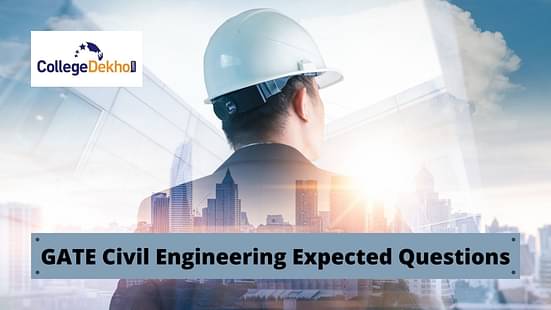The sections having the most weightage in the GATE 2025 CE syllabus include the most important questions in the exam. To prepare for the exam, students should focus on the most asked sections in the past few years’ GATE Civil Engineering question papers.

GATE 2025 Civil Engineering Most Expected Questions: The GATE 2025 exam preparation process requires hopefuls to study the subject matter thoroughly and practice all the GATE CE 2025 important questions. This requires solving the important questions and finding and gathering them to build a good study material resource that a student can refer to time and again. It is always recommended that the GATE hopefuls prepare the GATE 2025 CE (Civil Engineering) most expected questions for thorough and detailed exam preparation. If you are someone who is looking for all the important and different types of questions expected in GATE 2025 exam, you are at the right place. In this article, we have compiled some of the most expected questions in GATE 2025 exam, read along to know more.
Also Check: GATE 2025 Civil Engineering: Exam Date (Feb 16), Syllabus, Question Papers, Pattern, Cutoff
GATE CE 2025 Exam Date
First thing first, while preparing for the GATE 2025 Civil Engineering examination, students should know the correct date so they can create a well-rounded study plan. Check the table below, to know the GATE 2025 CE exam date:
Event | Date |
|---|---|
GATE Civil Engineering Exam Date | February 16, 2025 |
GATE Civil Engineering Results Date | March 19, 2025 |
Also Check: GATE 2025: Application Form Correction (Extended till Nov 20), Syllabus, Pattern, Tip
Quick Links:
| GATE 2025 Exam Date | GATE 2025 Eligibility Criteria |
|---|---|
| GATE 2025 Registration | GATE 2025 Admit Card |
| GATE 2025 Exam Pattern | GATE 2025 Exam Centres |
List of GATE 2025 CE (Civil Engineering) Expected Questions
Based on analyzing the past few years' GATE 2025 civil engineering papers and the GATE 2025 syllabus , we have compiled the following important civil engineering questions for the exam preparations. Students looking for the list of GATE civil engineering exam expected questions are given in this section:
1. The number of simultaneous equations to be solved in the slope deflection method, is equal to :
a. the degree of statical indeterminacy
b. the degree of kinematic indeterminacy
c. the number of joints in the structure
d. none of the above
2. On sag (or valley) curves the available sight distance is determined based on :
a. design speed
b. height of obstacle
c. height of the driver's eye
d. night-time driving conditions
3. The treatment that should be given to the water from a deep tube well is :
a. pre-settling only
b. coagulation and flocculation only
c. filtration only
d. disinfection only
4. The maximum size of a fillet weld for a plate of a square edge is
a. 1.5 mm less than the thickness of the plate
b. one-half of the thickness of the plate
c. the thickness of the plate itself
d. 1.5 mm more than the thickness of the plate
5. In a steady radial flow into an intake, the velocity is found to vary as (1/r2), where r is the radial distance. The acceleration of the flow is proportional to
a. 1/r5
b. 1/r3
c. 1/r4
d. 1/r
6. A round-bottom triangular lined canal is to be laid at a slope of 1 m in 1500, to carry a discharge of 25 m3/s. The side slopes of the canal cross-section are to be kept at 1.25H:1V. If Manning's roughness coefficient is 0.013, the flow depth (in meters) will be in the range of:
a. 2.39 to 2.42
b. 1.94 to 1.97
c. 2.24 to 2.27
d. 2.61 to 2.64
7. In the context of cross-drainage structures, the correct statement(s) regarding the relative positions of a natural drain (stream/river) and an irrigation canal, is/are:
a. In an aqueduct, natural drain water goes under the irrigation canal, whereas in a super-passage, natural drain water goes over the irrigation canal.
b. In a level crossing, natural drain water goes through the irrigation canal.
c. In an aqueduct, natural drain water goes over the irrigation canal, whereas in a super-passage, natural drain water goes under the irrigation canal.
d. In a canal syphon, natural drain water goes through the irrigation canal.
8. Assuming that there is no possibility of shear buckling in the web, the maximum reduction permitted by IS 800-2007 in the (low-shear) design bending strength of a semi-compact steel section due to high shear is:
a. Zero
b. 25%
c. 50%
d. governed by the area of the flange
9. As per IRC:37-2012, to control subgrade rutting in flexible pavements, the parameters to be considered are:
a. horizontal tensile strain at the bottom of the bituminous layer
b. vertical compressive strain on top of subgrade
c. vertical compressive stress on top of the granular layer
d. vertical deflection at the surface of the pavement
10. Road roughness is measured using
a. Benkelman beam
b. Bump integrator
c. Dynamic cone penetrometer
d. Falling weight deflectometer
GATE 2025 CE Syllabus
GATE 2025 Civil Engineering exam preparation requires a good understanding of the GATE 2025 Civil Engineering syllabus to identify all the important topics from the subject. Let’s have a look at topic-wise GATE 2025 important topics for exam preparation:
GATE 2025 Civil Engineering Important Topics
This section contains the list of the most important topics for the GATE 2025 civil engineering aspirants -
Topic | Important Sub-Topic/s | Expected Marks |
|---|---|---|
Surveying |
| 4 to 5 marks |
Engineering Hydrology |
| 2 to 4 marks |
Strength of Materials |
| 6 to 8 marks |
Geotechnical Engineering |
| 14 to 16 marks |
Fluid Mechanics |
| 7 to 9 marks |
Steel Structure |
| 3 to 4 marks |
Structural Analysis |
| 2 to 4 marks |
Reinforced Cement Concrete (RCC) |
| 6 to 7 marks |
Environmental Engineering |
| 12 to 14 marks |
Irrigation Engineering |
| 2 to 4 marks |
Transportation Engineering |
| 7 to 8 marks |

















Similar Articles
30 Days Preparation Plan for MET 2025
GATE Economics Preparation Strategy 2025- Major Topics, Study Plan, Sample Paper, Best Books
Electromagnetic Waves JEE Main Questions 2025: Important Practice Questions with PYQs
Electromagnetic Waves Weightage in JEE Main 2025
Magnetic Effects JEE Main Questions 2025: Important Practice Questions with PYQs
Magnetic Effects of Current Weightage in JEE Main 2025